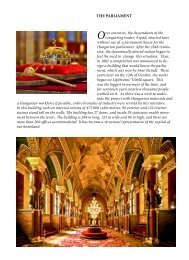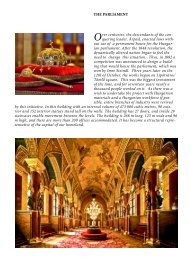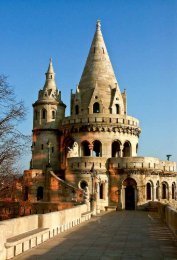You also want an ePaper? Increase the reach of your titles
YUMPU automatically turns print PDFs into web optimized ePapers that Google loves.
THE CHAIN BRIDGE<br />
In winter one used to be able to walk on the iced surface of the Danube, but during ice drifts,<br />
commuting in this way between the two banks of the river became impossible. Once, István<br />
Széchenyi was forced to wait an entire week in December of 1820 until he found one brave<br />
boatman who would take him to the other side. After this incident, he initiated the building of “the<br />
Bridge” . Building this bridge had historical significance, since it was the first permanent bridge<br />
between Pest and Buda. After being taken over by local traffic in 1849, it became a national<br />
symbol of development. Both Hungarians and visitors enjoyed the use of this bridge.<br />
DIE KETTENBRÜCKE<br />
Im Winter konnte man die Donau auch trockenen Fußes überqueren, beim Eisgang gab es<br />
jedoch keine Verbindung zwischen den Ufern. Die Brücke wurde auf Anregung des Grafen István<br />
Széchenyi erbaut, nachdem er im Dezember 1820 eine ganze Woche auf die Überquerung<br />
warten musste. Der Brückenbau war von historischer Bedeutung: Sie war die erste ständige<br />
Brücke zwischen Pest und Buda, die dem Verkehr 1849 übergeben wurde. Die Kettenbrücke ist<br />
ein Nationalsymbol und symbolisiert den technischen Fortschritt. Sie wird von den Ungarn und<br />
ausländischen Gästen geliebt.<br />
IL PONTE DELLE CATENE<br />
Un tempo, d’inverno era possibile attraversare il Danubio anche a piedi, ma con il disgelo si<br />
interrompeva regolarmente il collegamento tra le due rive. La costruzione del ponte fu caldeggiata<br />
dal conte István Széchenyi dopo il 1820, quando fu costretto ad aspettare una settimana finché<br />
qualcuno lo portasse dall’altra parte del fiume e, dunque, della città. La costruzione del Ponte<br />
delle Catene ebbe una notevole importanza storica perché fu il primo ponte stabile tra Buda<br />
e Pest. Consegnato nel 1849, il Ponte delle Catene è uno dei simboli nazionali, emblema del<br />
progresso, amato e rispettato dagli ungheresi.<br />
A LÁNCHÍD<br />
A Dunán télen évszázadokig száraz lábbal is át lehetett kelni, de jégzajláskor megszűnt az<br />
összeköttetés a két part között. A Híd építését Gróf Széchenyi István kezdeményezte, miután<br />
1820 decemberében teljes hetet kellett várnia, míg egy vakmerő hajós átjuttatta a túlpartra. A<br />
Lánchíd megépítése történelmi jelentőségű volt, ugyanis ez volt az első állandó híd Pest és Buda<br />
között, melyet 1849-ben adtak át a forgalomnak. A Lánchíd nemzeti jelkép. A haladás jelképe,<br />
melyet nem csupán tisztelnek, de szeretnek is a magyarok és az idelátogatók.<br />
56












